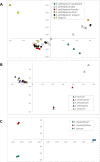Coding SNPs analysis highlights genetic relationships and evolution pattern in eggplant complexes
- PMID: 28686642
- PMCID: PMC5501601
- DOI: 10.1371/journal.pone.0180774
Coding SNPs analysis highlights genetic relationships and evolution pattern in eggplant complexes
Abstract
Brinjal (Solanum melongena), scarlet (S. aethiopicum) and gboma (S. macrocarpon) eggplants are three Old World domesticates. The genomic DNA of a collection of accessions belonging to the three cultivated species, along with a representation of various wild relatives, was characterized for the presence of single nucleotide polymorphisms (SNPs) using a genotype-by-sequencing approach. A total of 210 million useful reads were produced and were successfully aligned to the reference eggplant genome sequence. Out of the 75,399 polymorphic sites identified among the 76 entries in study, 12,859 were associated with coding sequence. A genetic relationships analysis, supported by the output of the FastSTRUCTURE software, identified four major sub-groups as present in the germplasm panel. The first of these clustered S. aethiopicum with its wild ancestor S. anguivi; the second, S. melongena, its wild progenitor S. insanum, and its relatives S. incanum, S. lichtensteinii and S. linneanum; the third, S. macrocarpon and its wild ancestor S. dasyphyllum; and the fourth, the New World species S. sisymbriifolium, S. torvum and S. elaeagnifolium. By applying a hierarchical FastSTRUCTURE analysis on partitioned data, it was also possible to resolve the ambiguous membership of the accessions of S. campylacanthum, S. violaceum, S. lidii, S. vespertilio and S. tomentsum, as well as to genetically differentiate the three species of New World Origin. A principal coordinates analysis performed both on the entire germplasm panel and also separately on the entries belonging to sub-groups revealed a clear separation among species, although not between each of the domesticates and their respective wild ancestors. There was no clear differentiation between either distinct cultivar groups or different geographical provenance. Adopting various approaches to analyze SNP variation provided support for interpretation of results. The genotyping-by-sequencing approach showed to be highly efficient for both quantifying genetic diversity and establishing genetic relationships among and within cultivated eggplants and their wild relatives. The relevance of these results to the evolution of eggplants, as well as to their genetic improvement, is discussed.
Conflict of interest statement
Figures




References
-
- FAO. http://faostat3.fao.org/home/E.org/ [Internet]. 2016.
-
- Fowler C, Moore G, Hawtin G. The International Treaty on Plant Genetic Resources for Food and Agriculture: A Primer for the Future of CGIAR. SGRP (System-Wide Genetic Resources Programme) I (now BI, editor. 2003.
-
- Kwon Y- I, Apostolidis E, Shetty K. In vitro studies of eggplant (Solanum melongena) phenolics as inhibitors of key enzymes relevant for type 2 diabetes and hypertension. Bioresour Technol. 2008;99: 2981–2988. doi: 10.1016/j.biortech.2007.06.035 - DOI - PubMed
-
- Akanitapichat P, Phraibung K, Nuchklang K, Prompitakkul S. Antioxidant and hepatoprotective activities of five eggplant varieties. Food Chem Toxicol. 2010;48: 3017–3021. http://dx.doi.org/10.1016/j.fct.2010.07.045 doi: 10.1016/j.fct.2010.07.045 - DOI - DOI - PubMed
-
- Stommel JR, Whitaker BD. Phenolic acid content and composition of eggplant fruit in a germplasm core subset. J Am Soc Hortic Sci. 2003;128: 704–710. Available: http://journal.ashspublications.org/content/128/5/704.abstract
MeSH terms
LinkOut - more resources
Full Text Sources
Other Literature Sources

